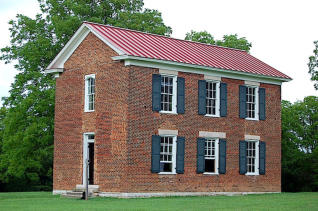
DOB: November 23, 1843
DOD: November 2, 1921
Age at Enlistment: 17
Date of Enlistment: May 9, 1861
Place of Enlistment: Franklin, TN
Rank at Enlistment: Private
Rank at Discharge: Private
Casualty: None
Comments: Henry Howe Cook was born in a house off of Wilson Pike in what is now Brentwood, TN next door to the historic
Ravenswood Mansion near Modern Day Ravenwood High School. Henry was educated at Boiling Springs Academy until 1858
(which is still standing on Moores Lane), when he was sent to Nashville to attend Franklin College. He was enrolled there when the
war broke out and returned home to enlist in the Williamson Grays. Henry’s older brother James Cook also served in the company.
Cook’s 1st Tennessee career was short lived. He was discharged for illness on October 26, 1861 at Greenbrier, VA. Cook made his
way home and enlisted in the 55th Tennessee on December 12, 1861. The regiment took heavy casualties at Shiloh and was
merged with the 44th Tennessee Infantry to form the 44th Consolidated Tennessee Infantry, which Cook became a member of
Company I. At the Battle of Murfreesboro on December 31, 1862, Cook was shot in the shoulder and the top of the head. The latter
wound took off part of his skull. He spent almost a year in Marietta, GA recovering and had a metal plate put on his head to help
cover the hole. Cook used to let children in Franklin bang on it after the war. He returned to his regiment at the end of 1863. The
44th Tennessee was reassigned to Longstreet’s Corps and went with him to fight at Knoxville before joining Lee’s Army. On May 16,
1864, the 44th Tennessee was engaged at Drewry’s Bluff and a good portion of the regiment was captured including Cook himself.
After his capture he was sent to Fort Delaware. He became part of the "Immortal 600" which was a group of 600 Confederate Officer
Prisoners that were sent to Morris Island in Charleston, SC and used as a human shield for 45 days from September to October
1864. Afterwards, he was sent to Fort Pulaski and eventually back to Fort Delaware and was released upon taking the Oath of
Allegiance on June 16, 1865. His prisoner of war record describes him as Complexion: Dark, Hair: Dark, Eyes: Dark, Height 5'9". In
May 1865, he wrote a letter to President Johnson stating he was “persuaded to do so by people much older than myself. After due
consideration, being more mature in years, I am willing and anxious to return home and live a peaceable life.”
Upon returning home he continued to study law and was admitted to the bar in 1867. He formed a Law Practice with Robert N.
Richardson (also a Williamson Gray) called Cook & Richardson. Later he formed a partnership with Park Marshall from 1877 to
1893. In 1870, he was elected County Judge in Williamson County and held the position until 1886. In 1896, he was elected
Chancellor for the region encompassing Davidson and Williamson Counties, which he held until 1902. He returned to Franklin and
was elected chairman of the board of examiners for the State of Tennessee, the board’s job was to examine applicants for the bar.
He married Fannie Marshall on August 17, 1882. The couple had one daughter named Genevieve. Both Henry’s wife and daughter
died about 10 years before him. His house was just a few blocks from the Courthouse and still stands at 403 Church Street in
Downtown Franklin. Cook’s photo was chosen for the “Typical Confederate” to be sculpted for a statue in Baltimore. The statue
stands near the College of Art on Mount Royal Avenue and was dedicated in 1903. He was also a Mason and a member of the
United Confederate Veterans. Henry Howe Cook died of Cancer on November 2, 1921 and is buried next to his wife and daughter in
Mount Hope Cemetery.

Mike Hoover is the web master and researcher for this page




Portrait of Henry H. Cook from the Tennessee
State Library and Archives





Boiling Springs Academy off
of Moores Lane in
Brentwood where Cook
attended school.
Cook’s Grave in Mount Hope
Cemetery in Franklin,
Section A
Dedication of the
Confederate Monument in
Baltimore in 1903. The
Confederate in the photo
was modeled after Cook’s
picture.
Cook’s house at 403 Church
Street in Franklin, TN.
Cook was a member of the John L. McEwen Bivouac of the United
Confederate Veterans in Franklin. His application is here.